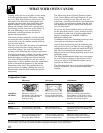
4
IMPORTANT SAFETY INSTRUCTIONS
(continued)
— Do not use the Sensor Features twice
in succession on the same food portion.
If food is undercooked after the first
countdown, use MICRO COOK for
additional cooking time.
— Do not use the oven for storage purposes.
Do not leave paper products, cooking
utensils or food in the oven when not in use.
— If materials inside the oven ignite, keep oven
door closed, turn oven off, and disconnect
power cord, or shut off power at the fuse or
circuit breaker panel.
• When using the convection or combination
cooking functions, both the outside and inside
of the oven will become hot. Always use hot
pads to remove containers of food and
accessories such as the metal accessory rack
and temperature probe.
• Oversized food or oversized metal cookware
should not be used in a microwave
/
convection
oven because they increase the risk of electric
shock and could cause a fire.
• Do not clean with metal scouring pads. Pieces
can burn off the pad and touch electrical
parts involving risk of electric shock.
• Do not use paper products when the
microwave
/
convection oven is operated
in the convection or combination mode.
• Do not store any materials, other than our
recommended accessories, in this oven when
not in use.
• Some products such as whole eggs and sealed
containers—for example, closed glass jars—
are able to explode and should not be heated in
this microwave
/
convection oven. Such use of
the microwave
/
convection oven could result
in injury.
• Avoid heating baby food in glass jars, even
with the lid off. Make sure all infant food is
thoroughly cooked. Stir food to distribute the
heat evenly. Be careful to prevent scalding when
warming formula or breast milk. The container
may feel cooler than the milk really is. Always
test the milk before feeding the baby.
• Don’t defrost frozen beverages in narrow
necked bottles (especially carbonated
beverages). Even if the container is opened,
pressure can build up. This can cause the
container to burst, possibly resulting in injury.
• Use foil only as directed in this guide.
TV dinners may be microwaved in foil trays
less than 3/4″ high; remove top foil cover and
return tray to box. When using foil in the
microwave
/
convection oven, keep foil at least
1″ away from sides of oven.
• Do not cover the shelf or any other part of
the oven with metal foil. This will cause over-
heating of the microwave
/
convection oven.
• Cookware may become hot
because of heat transferred from
the heated food. Pot holders may
be needed to handle the cookware.
• Sometimes, the oven floor and walls can
become too hot to touch. Be careful touching
the floor and walls during and after cooking.
• Foods cooked in liquids (such as pasta)
may tend to boil over more rapidly than foods
containing less moisture. Should this occur,
refer to the Care and Cleaning section(s) for
instructions on how to clean the inside of
the oven.
• Thermometer—Do not use regular cooking
or oven thermometers when cooking by
microwave or combination. The metal and
mercury in these thermometers could cause
“arcing” and possible damage to the oven.
Do not use a thermometer in food you are
microwaving unless the thermometer is
designed or recommended for use in the
microwave/convection oven.
• Remove the temperature probe from
the oven when not using it to cook with.
If you leave the probe inside the oven without
inserting it in food or liquid, and turn on
microwave energy, it can create electrical
arcing in the oven, damage oven walls and
damage the temperature probe.


















